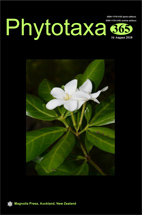Abstract
The highly distinctive genus Chichicaste is restricted to the Costa Rica-Chocó Biogeographic Hotspsot from Costa Rica to northwestern Colombia and comprises a single species, C. grandis. Relationships of this taxon have been doubtful in the absence of critical morphological analyses (particularly of living plants) and convincing molecular data. The present study aims at identifying the phylogenetic relationships of C. grandis using molecular and morphological data to establish its relationships. Our molecular data set includes four plastid markers (trnL–trnF, matK, trnS–trnG and rps16) and the nuclear marker ITS for 38 in-group taxa, including all of the currently recognized genera of the Loasoideae clade, and six out-group taxa from non Loasoideae Loasaceae and Hydrangeaceae. The dataset was analyzed using Maximum Likelihood and Bayesian Inference approaches. The plastid and nuclear trees were mostly congruent, with their respective ML best and BI strict consensus trees showing no significant differences in their topologies. Chichicaste is nested in Aosa series Parviflorae and sister to A. plumieri from Hispaniola, thus representing northern and western outliers of this otherwise strictly Brazilian genus. A critical morphological re-examination indicates that considering C. grandis as part of Aosa is plausible, in spite of the ecological and morphological differences between the two taxa. Based on these results the genus Chichicaste is synonymized with Aosa and the required new combination is provided. An amended key for an expanded Aosa, is also presented.

